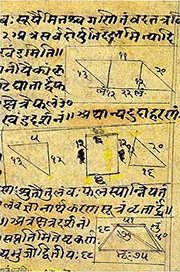Mahabja, Mahābja, Maha-abja: 5 definitions
Introduction:
Mahabja means something in Hinduism, Sanskrit. If you want to know the exact meaning, history, etymology or English translation of this term then check out the descriptions on this page. Add your comment or reference to a book if you want to contribute to this summary article.
In Hinduism
Ganitashastra (Mathematics and Algebra)
Source: archive.org: Hindu MathematicsMahābja (महाब्ज) is another name for Mahāsaroja, or a “trillion” (1,000,000,000,000), according to Nārāyaṇa (1356), as defined according to Śrīdhara in the Triśatikā, as defined according to the principles of gaṇita (“science of calculation”) and Gaṇita-śāstra, ancient Indian mathematics and astronomy.—We can definitely say that from the very earliest known times, ten has formed the basis of numeration in India. While the Greeks had no terminology for denominations above the myriad (104), and the Romans above the milk (103), the ancient Hindus dealt freely with no less than eighteen denominations [e.g., mahābja]. Cf. Yajurveda-saṃhitā (Vājasanyī) XVII.2; Taittirīya-saṃhitā IV.40.11, VII.2.20.1; Maitrāyaṇī-saṃhitā II.8.14; Kāṭhaka-saṃhitā XVII.10, XXXIX.6; Anuyogadvāra-sūtra 142; Āryabhaṭīya II.2; Triśatikā R.2-3; Gaṇitasārasaṃgraha I.63-68.

Ganitashastra (शिल्पशास्त्र, gaṇitaśāstra) refers to the ancient Indian science of mathematics, algebra, number theory, arithmetic, etc. Closely allied with astronomy, both were commonly taught and studied in universities, even since the 1st millennium BCE. Ganita-shastra also includes ritualistic math-books such as the Shulba-sutras.
Ayurveda (science of life)
Toxicology (Study and Treatment of poison)
Source: Shodhganga: Kasyapa Samhita—Text on Visha ChikitsaMahābja (महाब्ज) (or Mahāpadma) refers to “snakes that are ever blinking; neck marked with three stripes; head marked by lotus” and represents a classification of Divine Snakes, as taught in the Nāganāman (“names of the Sarpas”) section of the Kāśyapa Saṃhitā: an ancient Sanskrit text from the Pāñcarātra tradition dealing with both Tantra and Viṣacikitsā—an important topic from Āyurveda which deals with the study of Toxicology (Agadatantra or Sarpavidyā).—The first aspect of the Agadatantra is about the names of the sarpas and their features. The Kāśyapasaṃhitā verse IV.6-19 provide information on divine serpents [e.g., Mahābja], their characterstic features, origin and other details.

Āyurveda (आयुर्वेद, ayurveda) is a branch of Indian science dealing with medicine, herbalism, taxology, anatomy, surgery, alchemy and related topics. Traditional practice of Āyurveda in ancient India dates back to at least the first millenium BC. Literature is commonly written in Sanskrit using various poetic metres.
Languages of India and abroad
Sanskrit dictionary
Source: Cologne Digital Sanskrit Dictionaries: Monier-Williams Sanskrit-English DictionaryMahābja (महाब्ज):—[from mahā > mah] (hāb) m. Name of a serpent demon, [Kālacakra]
[Sanskrit to German]
Sanskrit, also spelled संस्कृतम् (saṃskṛtam), is an ancient language of India commonly seen as the grandmother of the Indo-European language family (even English!). Closely allied with Prakrit and Pali, Sanskrit is more exhaustive in both grammar and terms and has the most extensive collection of literature in the world, greatly surpassing its sister-languages Greek and Latin.
See also (Relevant definitions)
Full-text: Mahapadma, Mahasaroja.
Relevant text
Search found 3 books and stories containing Mahabja, Mahābja, Maha-abja; (plurals include: Mahabjas, Mahābjas, abjas). You can also click to the full overview containing English textual excerpts. Below are direct links for the most relevant articles:
The Agni Purana (by N. Gangadharan)
Chapter 51 - Characteristics of the images of the Sun and other planets
Chapter 294 - The characteristics of different kinds of serpents (nāga-lakṣaṇa)
The Padma Purana (by N.A. Deshpande)
Chapter 12 - Śiva Arrives on the Battlefield < [Section 6 - Uttara-Khaṇḍa (Concluding Section)]
Chapter 11 - Śiva’s Attendants Fight the Demons Off < [Section 6 - Uttara-Khaṇḍa (Concluding Section)]
Manasara (English translation) (by Prasanna Kumar Acharya)